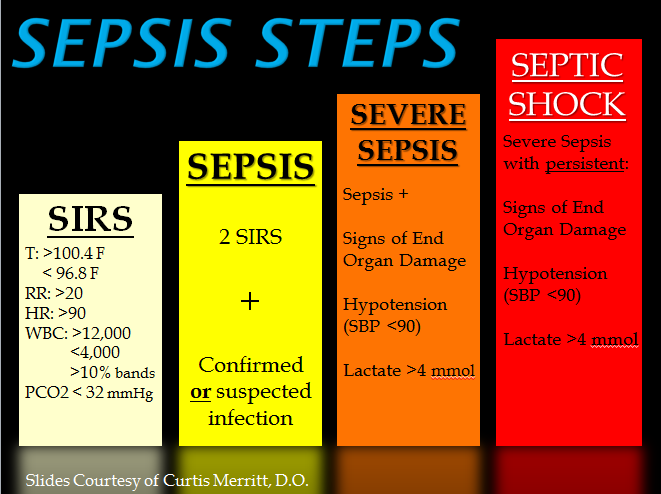Difference Between Sepsis and Septic Shock
What is Sepsis?
Definition of Sepsis:
Sepsis is an inflammatory response to an infection in which chemicals are produced that can cause damage to multiple organs in the body. Sepsis has a mortality rate of 10% to about 40%.
Symptoms of Sepsis:

The symptoms of sepsis include a fever with a body temperature that is above 101oF (38.3oC). Sometimes there can be chills in which the body temperature can be too low with sepsis in which case the temperature is lower than 96.8oF (36oC). Heart and breathing rate are fast. The rate of respiration is usually more than 20 breaths a minute and heart rate is usually more than 90 beats per minute.
Diagnosis and causes:
Diagnosis is based on the presence of a systemic inflammatory response syndrome (SIRS). Diagnosis can be made based on blood tests that show signs of infection, impaired electrolyte balance, abnormal liver function and kidney function and problems with blood clotting. There are several causes of sepsis, but the most common causes are an abdominal infection, kidney infection, pneumonia and bacteremia (blood infection).
Risk factors and complications:
Risk factors for sepsis include already being sick, being very old or very young, having a compromised immune system, having burns or other injuries and having invasive devices such as breathing tubes or catheters. Sepsis can cause a decrease in blood flow which can lead to blood clots forming and gangrene forming. Sepsis can progress to septic shock which can be deadly.
Treatment:
Sepsis is treated with intravenous broad-spectrum antibiotics and possibly vasopressor medications (if blood pressure is starting to drop).

What is Septic Shock?
Definition of Septic Shock:
Septic shock is a life-threatening infection in which sepsis progresses to such an extent that your blood pressure drops dangerously low to a systolic blood pressure of less than 90mm/Hg. Septic shock also results in very abnormal circulation and cell metabolism. Septic shock is very dangerous and has a death rate of 50%.
Symptoms:
Symptoms include low blood pressure (hypotension); cold, pale and clammy skin; nausea, diarrhea, and vomiting; and mental confusion. Urine output may also be decreased.
Diagnosis and causes:
Septic shock is indicated by the presence of a systolic blood pressure of less than 90mm/Hg. Septic shock is caused by severe sepsis that has not been treated or is not responding to treatment.
Risk factors and complications:
The main risk factor for septic shock is sepsis that is severe and associated with severe infection and injury. Being very sick in the hospital is a risk factor for sepsis and therefore for septic shock. Complications include respiratory failure, kidney failure, cardiac failure, and ultimately death.
Treatment:
Fluid resuscitation is important and is done to increase the blood pressure. Broad-spectrum intravenous antibiotics are given to treat the infection. Vasopressor medications are administered to raise blood pressure. Oxygen may be given and surgery may sometimes be needed.
Difference between Sepsis and Septic Shock?
-
Definition
Sepsis is an inflammatory response to an infection that can lead to organ failure due to the chemicals that are released. Septic shock is a life-threatening condition in which blood pressure drops dangerously low due to severe infection.
-
Symptoms
Sepsis is indicated by either a fever or chills and increased heart rate and increased respiration rate. Septic shock is indicated by low blood pressure; cold, pale and clammy skin; nausea; mental confusion and decreased urine output.
-
Diagnosis
Sepsis is diagnosed by the presence of systemic inflammatory response syndrome (SIRS) and various blood test results that indicate signs of severe infection. Septic shock is diagnosed by the presence of a very low blood pressure of less than 90mm/Hg.
-
Causes
Sepsis is caused by severe infection or injury. Septic shock is caused by severe sepsis that is not responding to treatment and that is worsening.
-
Risk factors
Risk factors for sepsis include being ill and very young or very old and having a compromised immune system. Having injuries such as burns and having invasive devices such as catheters are also risk factors for sepsis. The risk factor for septic shock is severe infection and injury that is not responding to treatment and being very sick in the hospital.
-
Complications
Sepsis can lead to blood clots, reduced blood flow causing gangrene, and septic shock. Septic shock can lead to kidney failure, respiratory failure, cardiac failure, and death.
-
Mortality rate
Sepsis has a mortality rate of about 10 to 40%, while septic shock has a higher mortality rate of 50%.
-
Treatment
Sepsis is treated with broad-spectrum IV (intravenous) antibiotics and vasopressor medications. Septic shock is treated with broad-spectrum IV antibiotics, vasopressor medications, fluid resuscitation, and oxygen therapy.
Table comparing Sepsis and Septic Shock

Summary of Sepsis Vs. Septic Shock
- Sepsis is an inflammatory response in which chemicals attack the organs of the body.
- Septic shock is a result of severe sepsis that does not respond well to treatment.
- Septic shock is indicated by very low blood pressure of 90mm/Hg.
- Both conditions can be treated with antibiotics, but the septic shock has a higher mortality rate.
- Difference Between Rumination and Regurgitation - June 13, 2024
- Difference Between Pyelectasis and Hydronephrosis - June 4, 2024
- Difference Between Cellulitis and Erysipelas - June 1, 2024
Search DifferenceBetween.net :
Leave a Response
References :
[0]Levinson, Andrew T., Brian P. Casserly, and Mitchell M. Levy. "Reducing mortality in severe sepsis and septic shock." Seminars in respiratory and critical care medicine. Vol. 32. No. 02. Thieme Medical Publishers, 2011.
[1]Maggio, Paul M. “Sepsis and Septic Shock”. Merckmanuals. Merck & Co., 2018, https://www.msdmanuals.com/professional/critical-care-medicine/sepsis-and-septic-shock/sepsis-and-septic-shock
[2]Mayo Clinic. “Sepsis”. Mayo clinic. Mayo Clinic, 2018, https://www.mayoclinic.org/diseases-conditions/sepsis/symptoms-causes/syc-20351214
[3]Image credit: https://www.flickr.com/photos/45909111@N00/8603350712
[4]Image credit: https://upload.wikimedia.org/wikipedia/commons/a/ad/Sepsis_Steps.png
